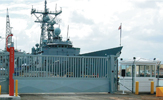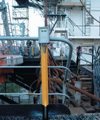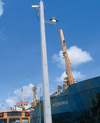

Solutions range from intelligent digital surveillance systems to biometrics, trace detection, container security devices and anti-terrorist vehicle barriers.
With ports commonly perceived as a vulnerable area when it comes to security, a discussion about emerging technologies that can help secure cargo - and ports themselves - could not be more timely. From cargo container security devices, to biometrics that guarantee only authorised truck drivers enter ports, to advanced, intelligent digital video surveillance systems, to vehicle barriers and trace detection technology that prevent terrorists from driving bomb-laden trucks into ports, the solutions exist today to bring port and cargo security at least to levels comparable to that of their more attention-getting cousins, airports.
Anti-terrorist barriers keep the bad guys out
Ports around the world are employing counter-terrorist vehicle control systems to ensure that unauthorised vehicles are unable to enter secure port areas and wreak havoc on shipping operations. After all, a port is a perfect target for a truck bombing. A strategic attack could literally destroy a port's infrastructure and figuratively send ripples through a worldwide economy.
To counter this and protect vulnerable piers, the Naval Station Pearl Harbor in Hawaii is using automated, linear gates. The equipment was installed as part of an overall regional effort to increase the force protection posture of critical assets at strategic locations. They create a protective barrier between terrorists and in-port assets.
"The navy installed this barrier system in order to provide an adequate level of force protection while maintaining a high level of efficiency on the piers. In other words, we have been able to increase our force protection posture without impacting the mission of fleet support," reports Andrew Iuvale, anti-terrorism director, Navy Region Hawaii. "Before the gates were installed, as one approached the pier they came upon a swing gate guarded by a sentry. It was the sentry's responsibility exclusively to assess and then grant or deny access. For a bad guy to access the piers, they only had to overcome the sentry."
Now, the piers have a gate or kiosk system that protects the sentry, who remains in the gatehouse and cannot be touched. Anyone attempting to gain access has to slide credentials through a pass window to the sentry.
"However, even if someone could take out a sentry in the gatehouse, they still cannot get through the gates," Iuvale explains. "These new gates are 'force multipliers' for the Security Department when operating them in an automated mode during slow periods. An automated gate reduces overall manpower requirements and frees up security personnel to perform other missions vital to force protection such as patrol, counter surveillance and random inspections."
The endstate will have a sentry in a central location controlling any one or all of the gates depending on mission requirements, he added.
"Pearl Harbor's piers are now less vulnerable to acts of terrorism," says Lt Jeremy Gates, Naval Facilities construction team leader. "The automated gates provide an anti-terrorism force protection barrier between roadways and the piers which provide service to ships and submarines. Physical security upgrades such as this, combined with anti-terrorism awareness training, helps make navy personnel less vulnerable from attacks and acts of terrorism."
In addition to the fixed, crash-rated gates produced by Delta Scientific, Pearl Harbor also uses Delta's portable barricades, which are towed into place and set up in 15 minutes. According to Iuvale, the fixed barriers and portable barriers are integrated with a series of other force protection equipment and measures to achieve an antiterrorism system based on a defence-in-depth methodology.
Such anti-terrorist barriers also secure civilian ports. At Australia's Sydney Harbour, anti-terrorist barriers protect the international cruise ship terminal at the Port of Sydney. The barriers lie flat in the road until activated, at which point they spring up at a 45° angle and effectively stop a speeding vehicle in its tracks.
They can stop and destroy a 6800 kg (66,7 kN) vehicle travelling at 80 kph. Set in a foundation only 46 cm deep, the barriers are able to survive and operate after a 1,2 million foot pound impact.
At the Port of Sydney Harbour, the barriers prevent speeding vehicles from getting past the guard post at the Overseas Passenger Terminal at Circular Quay, where about 90 vessels are expected to dock during the busy summer months. Nearly 160 000 passengers are expected to come through the Port, representing a major facet of Australia's tourism industry. Other heightened security measures include closed circuit TV cameras, exclusion zones and security patrols.

Biometrics let the good guys in
Just as it is important to keep the bad guys out, one needs to also let the good guys in. Biometric systems are already being used at ports around the globe to heighten security and make sure only authorised individuals enter the ports.
In order to quickly move cargo through its facility, while still maintaining extremely high security, Europe's two largest ports - Rotterdam and Antwerp - use Schlage Recognition Systems biometric hand geometry readers together with smart chip cards as a fast method of identifying drivers, avoiding costly transport delays while still ensuring the highest security. The card looks like a normal credit card, but the chip in the card is a minicomputer that stores a three-dimensional template of the left hand of the cardholder.
The advantages of the biometrically-enhanced system are many: information cannot be manipulated or changed; the driver does not have to remember specific information such as a PIN code; the card cannot be transferred to other people; mistakes as a result of typing in incorrect ID numbers are impossible.
Using biometric systems, both ports are able to more quickly and accurately verify the identities of authorised employees and visitors at port entrances. The biometric-based solution im-proves security and safety as well as operating efficiencies.
Controlling movement within ports
Ingersoll-Rand has developed an initiative that aims to integrate security and port operations technology in ways that will help control costs. "The role of a port is to take cargo off ships and put it on trucks or railcars," says James Ligotti, vice president of maritime solutions with Ingersoll Rand Security Technologies. "Most ports keep track of people with time-and-attendance systems. Leading ports use biometrics to control access and egress. They use sophisticated asset tracking systems. They can now integrate increased security into each process."
For instance, by tying a digital video recording system to the asset tracking, ports can check video of what is happening and what has happened to a specific container as it moves from ship to shore and beyond. Access control systems can work with transportation worker identification cards (TWIC).
According to Ligotti, TWIC is currently being tested at the Port of Los Angeles Long Beach, Philadelphia and Florida and Ingersoll-Rand is suggesting systems in which forklifts would not operate without the use of the TWIC. Only authorised operators could do so. Sensors would then track the forklift on its journeys around the port.

Sniffing out explosive
Technology that is now being used, or currently being developed, to detect traces of explosives in air cargo is also finding a home at shipping ports.
In a recently-announced programme, the US Department of Homeland Security (DHS) will use trace detection technologies in a $30 million pilot programme to screen passenger aircraft cargo for explosives at San Francisco Airport's (SFO) air cargo facilities and two other US airports. A major tenet of the programme, a collaboration between DHS's Science and Technology (S&T) Directorate and the Transportation Security Administration (TSA), is to use currently available commercial technology for screening air cargo.
Among the systems or techniques now used for baggage screening that will also be deployed for cargo screening are Explosive Detection Systems, other Explosive Trace Detectors and standard X-ray machines, as well as canine teams and manual inspectors.
The objective of the Air Cargo Explosives Detection Pilot Program is to better understand the technological and operational issues associated with explosives detection for air cargo. This work will provide critical knowledge to help in making future decisions on the national air cargo security infrastructure as well as assisting in the research and development planning to support air cargo security.
To advance the field, the Department of Homeland Security is already funding the development of new screening technologies for explosives, such as advanced X-ray systems that can screen entire pallets at once. This technology could also prove critical for detecting explosives in shipping ports.
The S&T Countermeasures Test Beds programme provides DHS with an independent and objective testing capability. This program provides information about scientific, economic and operational issues associated with deploying technologies. Additionally, the program provides data to decision-makers as to which technologies are suitable for different missions, such as cargo at shipping ports.
Checking for tampered cargo containers
With 60 million cargo containers moving around the world and approximately 27 000 entering the United States on any single day, containerised freight is a recognised vulnerability. In fact, most believe it is much more likely terrorists will target maritime cargo than aviation to do real harm as it is estimated that a US port closure could cost up to $1 trillion. Technology, though, is now available to protect cargo containers.
Starbucks is installing GE's CommerceGuard on shipments of green coffee beans originating in Guatemala, bound for the United States and Europe.
It features a container security device (CSD) that enables the monitoring of container movements, including door-opening events, and regularly updates users throughout the entire international shipping process. During a three-month test period with Starbucks, the CSDs accurately recorded all door-opening events. Additionally, the CSDs were easily installed and armed in remote coffee-growing areas throughout the Starbucks' test phase.
"Starbucks recognises that enhancing international supply chain security while reducing the risk of suspending container traffic, contributing to realtime management and quality assurance are necessary in order to ensure that worldwide commerce can operate in a wide range of security conditions," said Dorothy Kim, executive vice president of Starbucks Supply Chain Operations. "We are taking a proactive approach in securing our supply chain to ensure the safety of our customers, partners (employees), communities and countries of origins. CommerceGuard is an enabler in helping us move towards that goal."
The CSD magnetically adheres to the inside of an international cargo container. Fixed and handheld readers record the status of the CSD in a database that can be accessed by authorised importers, shippers and government officials anywhere in the world.
Watching over the whole port
With the emergence of ever increasing security demands, ports have already recognised the need for advanced video security management systems. The complex surveillance systems of a port can be quite expensive. Thus, most ports are installing systems that embrace both new and legacy surveillance components within a large-scale, intelligent video platform that provides optimal networking performance.
For instance, the Miami River port uses an extensive, integrated video surveillance system to enhance security at its port businesses, which handle more than $4 billion worth of commerce to and from the Caribbean and Central and South America.
In the wake of the September 11 attacks, the port secured two federal grants from the Transportation Security Administration to increase security by installing video surveillance systems.
The first grant purchased 11 day/night pan-tilt-zoom cameras with infrared capabilities, which were installed along the Miami River. Video from these cameras is transmitted wirelessly to a command centre on the river and then to local law enforcement agencies.
The second TSA grant enabled the marine group to install a more extensive, fully integrated video surveillance system that includes the group's 20 member terminals. The high performance, day/night colour surveillance system includes more than 218 cameras, 20 Triplex DVRs, and 40 21-inch colour monitors. The day/night cameras are mounted in weatherproof housings.
The 20 terminals can now monitor cameras on site or remotely via the Internet. The video footage can also be monitored at a central monitoring station by local law enforcement agencies in case of an emergency or a federal maritime security Level 3 alert. Almost immediately after the system went online, a robbery occurred in front of a port business, and police were able to access the footage.
Improving port security
Recent US legislation calls for increased funding for port security to provide universal inspection of incoming cargo and other measures to prevent smuggling of biological, chemical or nuclear weapons. That is a good first step, but even improved inspection efforts will only affect a fraction of all shipments. However, there is much that private industry can do now to ensure that assets ranging from cargo to ports themselves - and of course invaluable human assets - are protected. The technology exists and it is both affordable and effective.

© Technews Publishing (Pty) Ltd. | All Rights Reserved.